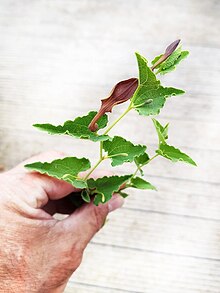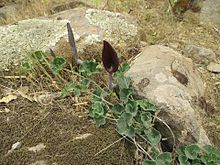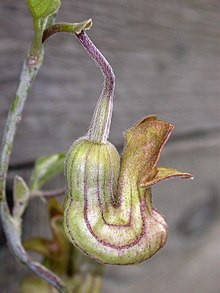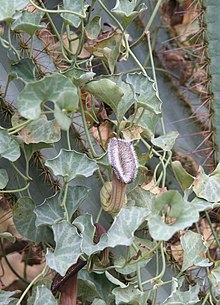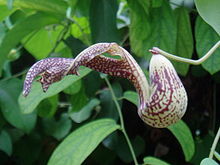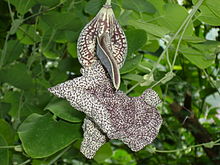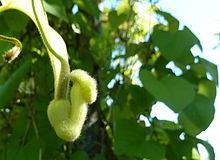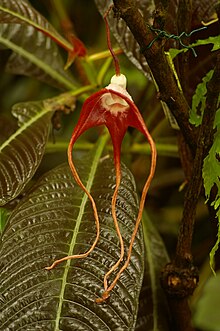Pipe flowers
| Pipe flowers | ||||||||||||
|---|---|---|---|---|---|---|---|---|---|---|---|---|

Large easter lucei ( Aristolochia gigantea ) |
||||||||||||
| Systematics | ||||||||||||
|
||||||||||||
| Scientific name | ||||||||||||
| Aristolochia | ||||||||||||
| L. |
The pipe flowers ( Aristolochia ), also called pipe winds or Osterluzei , are a genus of plants in the family of the Osterluzei family (Aristolochiaceae). This genus includes around 400 to 500 species. They are widespread and can be found in many climates. Some climber species are most common in cultivation because of their heart-shaped leaves and unusually shaped flowers.
description
Appearance and leaves
Aristolochia species grow as evergreen or deciduous, woody shrubs or climbing plants (lianas) or rarely independently upright, mostly prostrate, climbing or climbing, perennial herbaceous plants . Tubers are often formed as persistence organs. The plant parts often contain essential oils . There is secondary growth in thickness based on a conventional cambium ring.
The alternate and helically arranged leaves are sometimes divided into a leaf sheath, but always into a petiole and a leaf blade. The very short to long petioles are often grooved on the upper side. The membranous to leathery leaf blades are simple and often heart-shaped or less often three- to seven-lobed. The leaves can be dotted with glands. The leaf nerve is very different depending on the species. There are no stipules , but "pseudostipules" are sometimes present.

Inflorescences, flowers and flower ecology
The flowers are individually in the leaf axils or on the stem ( cauliflora ) or in groups in lateral or stem- borne, zymous , racemose , paniculate or spike-like inflorescences . There are bracts .
The small to large badly smelling or odorless flowers are mostly strongly zygomorphic , less often radial symmetry and threefold with a simple flower envelope . There are only sepals but no petals. The three sepals have grown together to form a tube. The calyx tube, which is often hairy on the inside, is often elongated and straight or curved to S-shaped near its base, as well as cylindrical or funnel-shaped at the top with a tongue-, disc- or almost shield-shaped calyx lip, which ends in one to three calyx lobes or less often up to six calyx teeth . The colors of the sepals range from green, brown to red to purple. There are seldom three, usually six or twelve fertile stamens present, which have grown together to form a tube and with the stylus to form a gynostemium . Three, five or six carpels have become an under-earth, three, five or sechskammerigen and three-, five- or six-edged ovary completely overgrown. The stylus area of the gynostemium is three-, five- or six-lobed. The tetrasporangiaten anthers can have appendages. Each ovary chamber contains 20 to 50 hanging or horizontal, mostly anatropic ovules in a central-angled placentation . There are two to six nectaries at the base of the cauldrons . A discus can be present.
Pollination takes place by insects ( entomophilia ), mostly two-winged birds (Diptera). The flowers of many species have a special pollination mechanism: They are "kettle trap flowers". They have a strong smell to attract certain insects. The inner area of the flower tube is hairy, this ensures that the attracted insect can only leave the flower when it is covered with pollen and can thus pollinate other flowers.
Fruits and seeds


When ripe, the dry capsule fruits usually open with six flaps, depending on the species, starting from the tip or the base (they rarely remain closed) and contain many seeds. The flat or plano-convex, egg-shaped or triangular seeds sometimes have wings or sometimes membranous elaisomes . There is an oily endosperm and only a rudimentary to poorly developed embryo when the seeds are ripe . The seed coat (testa) is smooth or has warts.
Sets of chromosomes
The basic chromosome numbers are x = 6, 7, 8.
ingredients
Aristolochia species often contain aristolochic acids . The roots of the common easter egg ( Aristolochia clematitis ) contain up to 1 percent aristolochic acids. These are dangerous. Aristolochic acids are genotoxic , nephrotoxic and even carcinogenic in animal experiments . There could also be a connection with urothelial carcinoma in humans.
Systematics
The genus Aristolochia was first published in 1753 by Carl von Linné in Species Plantarum , 2, pp. 960-962. Aristolochia rotunda L. was established as the lectotype in 1913 . Synonyms for Aristolochia L. are: Einomeia Raf. , Endodeca Raf. , Euglypha Chodat & Hassl. , Holostylis Duch. and Isotrema Raf. The genus Aristolochia belongs to the subfamily Aristolochioideae in the Aristolochiaceae family . The generic name Aristolochia is already the name of an Aristolochia species in Theophrastus and is derived from āριστος áristos for very good and λóχος lóchos for confinement or childbirth, this refers to the use of the drug as an obstetric agent.
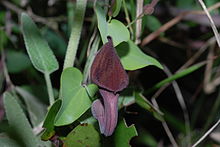

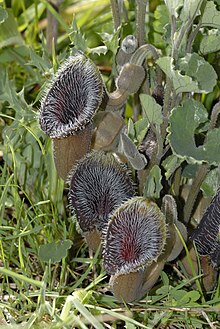



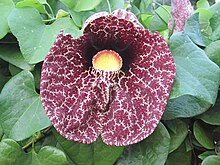




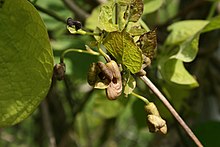


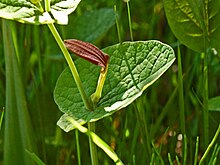





There are about 480 species of Aristoloch :
- Aristolochia acontophylla Pfeifer
- Aristolochia acuminata Lam. : It occurs in India, Nepal, Bangladesh, Bhutan, Sri Lanka, Indonesia, Malaysia, the Philippines, Thailand, Cambodia, Myanmar, Vietnam, China, Japan, Taiwan, Papua New Guinea, the Solomon Islands and Australia.
- Aristolochia acutifolia Duch.
- Aristolochia albertiana Ahumada
- Aristolochia albida Duch. : It occurs in Sudan, Kenya, Tanzania, Burundi, Cameroon, Rwanda, Zaire, Burkina Faso, Ivory Coast, Senegal, Ghana, Nigeria, Angola, Malawi, Zimbabwe, Zambia, Madagascar and Mayotte .
- Aristolochia allemanii Hoehne
- Aristolochia amara (Aubl.) Poncy
- Aristolochia andina F.González & IGVargas
- Aristolochia anguicida Jacq.
- Aristolochia angustifolia Cham.
- Aristolochia antennifera L. Uribe
- Aristolochia apoloensis Rusby
- Aristolochia arborea Linden : This shrubby species, whose flowers mimic mushroom fruiting bodies, comes from Mexico.
- Aristolochia arborescens L.
- Aristolochia arcuata mast. : It occurs in Brazil.
- Aristolochia arenicola Hance
- Aristolochia argentina Griseb.
- Aristolochia argyroneura Hoehne ex Uribe
- Aristolochia asclepiadifolia Brandegee
- Aristolochia asperifolia Ule ex Pilg.
- Aristolochia atropurpurea Parish ex Hook. f.
- Aristolochia auricularia Boiss. : It occurs in Turkey.
- Aristolochia austrochinensis C.Y.Cheng & JSMa : It occurs in the Chinese provinces of Fujian, Guangdong, Guangxi and Hainan.
- Aristolochia baenzigeri B. Hansen & Phuph.
- Southern Spanish easter egg ( Aristolochia baetica L. ): It occurs in Morocco, Algeria, Portugal, Gibraltar and Spain.
- Aristolochia bahiensis F.González
- Aristolochia balansae Franch.
- Aristolochia bambusifolia C.F. Liang ex HQWen : It occurs in the Chinese province of Guangxi.
- Aristolochia baracoensis R. Rankin
- Aristolochia barbourii Barringer
- Aristolochia baseri Malyer & Erken
- Aristolochia batucensis Wiggins & Rollins
- Aristolochia bianorii Sennen & Pau : It occurs on Mallorca and Menorca.
- Aristolochia bicolor Ule ex Pilg.
- Aristolochia bilabiata L .: It occurs in Cuba, Haiti, the Dominican Republic, Puerto Rico and the American Virgin Islands .
- Aristolochia billardieri Jaub. & Spach : It occurs in Turkey, Syria, Lebanon, Jordan and Israel.
- Aristolochia bilobata L.
- Aristolochia birostris Duch.
- Aristolochia boliviensis Kuntze
- Aristolochia boosii panther
- Aristolochia bottae Jaub. & Spach
- Aristolochia brachyura Duch.
- Aristolochia bracteolata Lam. : It occurs in southern Egypt, Sudan, Somalia, Chad, Ethiopia, Eritrea, Djibouti, Kenya, Tanzania, Uganda, Niger, Nigeria, Burkina Faso, the Arabian Peninsula, Pakistan, India and Sri Lanka.
- Aristolochia bracteosa Duch.
- Aristolochia brevifolia (Cham.) Hauman
- Aristolochia brevilabris Bornm. : It occurs in Turkey.
- Aristolochia brevipes Benth.
- Aristolochia bridgesii (Klotzsch) Duch.
- Aristolochia buchtienii O.C. Schmidt
- Aristolochia bukuti Poncy
- Aristolochia bullata Piper
- Aristolochia buntingii Piper
- Aristolochia burchellii mast.
- Aristolochia burelae Duke
- Aristolochia burkartii Ahumada
- Aristolochia cabrerae Ahumada
- Aristolochia californica Torr. : It occurs only in northern and western California.
- Aristolochia cambodiana Pierre ex Lecomte
- Aristolochia cardiantha Pfeifer
- Aristolochia carterae Piper
- Aristolochia castellanosii Ahumada
- Aristolochia caudata Jacq.
- Aristolochia caulialata C.Y.Wu ex CYCheng & JSMa : It occurs in the Chinese provinces of Fujian and Yunnan.
- Aristolochia cauliflora Ule : It occurs in Peru and probably also in the Brazilian Amazon.
- Aristolochia ceresensis Kuntze
- Aristolochia chachapoyensis Ahumada
- Aristolochia chalmersii O.C. Schmidt
- Traubige Osterluzei ( Aristolochia chamissonis (Klotzsch) Duch. )
- Aristolochia championii Merr. & Chun : It occurs in the Chinese provinces of Guangdong, Guangxi, Guizhou and Sichuan.
- Aristolochia chasmema Pfeifer
- Aristolochia chiapensis J.F. Ortega & RVOrtega
- Aristolochia chilensis Bridges ex Lindl. : It occurs in Chile.
- Aristolochia chiquitensis Duch.
- Aristolochia chlamydophylla C.Y.Wu : It occurs in the Chinese provinces of Guangxi and Yunnan.
- Aristolochia chrysochlora Barb. Rodr.
- Aristolochia cilicica P.H.Davis & MSKhan : It occurs in Turkey.
- Aristolochia claveriana L. Uribe
- Aristolochia clavidenia Griseb.
- Common easter lucei ( Aristolochia clematitis L. ): A European species that was previously grown for its medicinal properties.
- Aristolochia clementis Alain
- Aristolochia clusii Lojac. : It occurs in Italy, Sicily and Malta.
- Aristolochia clypeata Linden & André
- Aristolochia coadunata Backer
- Aristolochia colimensis Santana Mich.
- Aristolochia colombiana F.González
- Aristolochia colossifolia Hoehne
- Aristolochia conferta Mill.
- Aristolochia consimilis mast.
- Aristolochia contorta Bunge : It occurs in China, Japan, KOrea and in Russia's Far East.
- Aristolochia conversiae Piper
- Aristolochia cordata Eastw.
- Aristolochia cordiflora Mutis ex Kunth
- Aristolochia cordigera (Klotzsch) Duch.
- Aristolochia cornuta mast.
- Aristolochia cortinata Reinecke
- Aristolochia coryi I.M.Johnst. : It occurs in Texas and Mexico.
- Aristolochia crassinervia O.C. Schmidt
- Aristolochia cremersii Poncy
- Cretan Easter luzei ( Aristolochia cretica Lam. )
- Small easter lucei ( Aristolochia cruenta Barringer )
- Aristolochia cubensis Linden
- Aristolochia cucurbitifolia Hayata : It occurs in Taiwan.
- Aristolochia cucurbitoides C.F.Liang : It occurs in Myanmar and in the Chinese provinces of Guangxi, Guizhou and Yunnan.
- Aristolochia curtisii King ex Gamble
- Aristolochia curviflora Malme
- Hanging easter egg ( Aristolochia cymbifera Mart. ): It occurs in Brazil.
- Aristolochia cynanchifolia Mart.
- Aristolochia daemoninoxia mast.
- Aristolochia dalyi F.González
- Aristolochia dammeriana mast.
- Aristolochia davilae Calzada, JGFlores & O.Téllez
- Aristolochia debilis sieve. & Zucc. : It occurs in China and Japan.
- Aristolochia decursivebracteata Hoehne
- Aristolochia delavayi Franch. : It occurs in Sichuan and Yunnan.
- Aristolochia deltoidea Kunth
- Aristolochia didyma S.Moore
- Aristolochia dilatata N.E.Br.
- Aristolochia dinghoui Favio González & O.Poncy
- Aristolochia disticha mast.
- Aristolochia domingensis Ekman & OCSchmidt
- Aristolochia dongnaiensis Pierre ex Lecomte
- Aristolochia droseroides horns
- Aristolochia durangensis Piper
- Aristolochia echinata Barb. Rodr.
- Aristolochia eggersii horns
- Aristolochia ehrenbergiana Cham.
- Aristolochia ekmanii O.C. Schmidt
- Aristolochia elegans mast. : It is native to Colombia, Ecuador, Bolivia, Peru, Brazil, Argentina and Paraguay.
- Aristolochia elongata (Duch.) E. Nardi : It occurs in Albania and Greece.
- Aristolochia embergeri Nozeran & N. Hall
- Aristolochia emiliae Santana Me. & Solís
- Aristolochia erecta L .: It occurs in Texas and Mexico.
- Aristolochia eriantha Mart.
- Aristolochia ernestulei Hoehne
- Aristolochia esoterica Piper
- Aristolochia esperanzae Kuntze : It occurs in Brazil, Argentina, Bolivia and Paraguay.
- Aristolochia fangchi Y.C.Wu ex LDChow & SMHwang : It occurs in the Chinese provinces of Guangdong, Guangxi and Guizhou.
- Aristolochia filipendula Duch.
- Aristolochia fimbriata Cham. : It is native to Brazil, Argentina, Paraguay and Uruguay.
- Aristolochia flava Poncy
- Aristolochia flexuosa Duch.
- Aristolochia floribunda Lem.
- Aristolochia foetida Kunth
- Aristolochia fontanesii Boiss. & Reut. : It occurs in Algeria.
- Aristolochia fordiana Hemsl. : It occurs in the Chinese provinces of Guangdong and Guangxi.
- Aristolochia forrestiana J.S.Ma : It occurs in Yunnan.
- Aristolochia fosteri Barringer
- Aristolochia foveolata Merr. : It occurs in the Philippines and Taiwan.
- Aristolochia fragrantissima Ruiz
- Aristolochia fuertesii Urb.
- Aristolochia fujianensis S.M. Hwang : It occurs in the Chinese provinces of Fujian and Zhejiang.
- Aristolochia fulvicoma Merr. & Chun : It occurs on Hainan.
- Aristolochia galeata Mart. & Zucc. : It occurs in Brazil.
- Aristolochia gardneri Duch.
- Aristolochia gaudichaudii Duch.
- Aristolochia gehrtii Hoehne
- Aristolochia geniculata E. Nardi : It occurs in Turkey.
- Aristolochia gentilis Franch. : It occurs in Sichuan and Yunnan.
- Aristolochia georgica R.E. Schul.
- Aristolochia gibertii Hook.
- Large Easter Luzei ( Aristolochia gigantea Mart. ): It is originally found in the Brazilian states of Bahia, Minas Gerais, Parana and Sao Paulo.
- Aristolochia ginzbergeri Ahumada
- Aristolochia glaberrima Hassl.
- Aristolochia glandulosa J. Kickx f. : It occurs in Cuba.
- Aristolochia glaucescens Kunth
- Aristolochia glaucifolia Ridl.
- Aristolochia glossa piper
- Aristolochia goliathiana Mich.J.Parsons
- Red easter egg ( Aristolochia gorgona M.A. Blanco )
- Aristolochia goudotii Duch.
- Aristolochia gourigangaica N.C.Nair
- Delicate Easter luzei ( Aristolochia gracilis Duch. )
- Large-flowered Easter luzei ( Aristolochia grandiflora Sw. ): It occurs in Mexico, Guatemala, El Salvador, Belize, Honduras, Nicaragua, Costa Rica, Panama, Colombia and Ecuador.
- Aristolochia grandis Craib
- Aristolochia griffithii Hook. f. & Thomson ex Duch. : It occurs in northeastern India, in Nepal, Bhutan, Sikkim, Myanmar and in the Chinese provinces of Xizang and Yunnan at altitudes between 2100 and 2800 meters.
- Aristolochia guadalajarana S. Watson
- Aristolochia guentheri O.C. Schmidt
- Aristolochia guianensis Poncy
- Aristolochia guichardii P.H.Davis & MSKhan : It occurs in Turkey and in the Aegean Sea.
- Aristolochia hainanensis Merr. : It occurs in Hainan and Guangxi.
- Aristolochia haitiensis Ekman & OCSchmidt
- Aristolochia hansenii Phuph.
- Aristolochia harmandiana Pierre ex Lecomte
- Aristolochia hatschbachii Ahumada
- Aristolochia helix Phuph.
- Aristolochia heppii Merxm.
- Aristolochia hians Willd.
- Aristolochia hilariana Duch.
- Aristolochia hirta L .: It occurs in Greece, in European and Asian Turkey and in the Aegean.
- Aristolochia hispida Pohl ex Duch.
- Aristolochia hockii De Wild.
- Aristolochia hoehneana O.C.Schmidt
- Aristolochia holostylis F.González : It occurs in Brazil, in eastern Bolivia and in Paraguay.
- Aristolochia holtzei F. Muell.
- Aristolochia hookeriana Craib
- Aristolochia howii Merr. & Chun : It occurs in Hainan.
- Aristolochia huberiana S. Moore
- Aristolochia huebneriana O.C. Schmidt
- Aristolochia humilis Merr.
- Aristolochia hypoglauca Kuhlm.
- Aristolochia hyrcana P.H.Davis & MSKhan
- Aristolochia iberica fish. & CAMey. ex Duch. : It occurs in Turkey, Georgia and Azerbaijan.
- Aristolochia imbricata mast.
- Aristolochia impressinervis C.F. Liang : It occurs in Guangxi.
- Aristolochia impudica J.F. Ortega
- Aristolochia incisa Duch. : It occurs in Turkey and in the Aegean Sea.
- Aristolochia incisiloba Jongkind
- Aristolochia indica L .: It is native to India and Sri Lanka and is a neophyte in Australia.
- Aristolochia inflata Kunth
- Aristolochia insignis Verschaff.
- Aristolochia iquitensis O.C. Schmidt
- Aristolochia isaurica E. Nardi : It occurs in Turkey.
- Aristolochia islandica Piper
- Aristolochia jackii Steud.
- Aristolochia jauruensis Hoehne
- Aristolochia jianfenglingensis Han Xu, YD Li & HQ Chen : It occurs on Hainan.
- Aristolochia jingiangensis H.Zhang & CKHsieh
- Aristolochia kaempferi Willd. : It occurs in China, Japan and Taiwan.
- Aristolochia kanukuensis Feuillet
- Aristolochia karwinskii Duch.
- Aristolochia Kerrii Craib
- Aristolochia killipiana O.C. Schmidt
- Aristolochia klossii Ridl.
- Aristolochia klugii O.C. Schmidt
- Aristolochia kongkandae Phuph.
- Aristolochia krausei P.H.Davis : It occurs in Turkey.
- Aristolochia Krisagathra Sivar. & Pradeep
- Aristolochia krukoffii O.C. Schmidt
- Aristolochia kunmingensis C.Y.Cheng & JSMa : It occurs in the Chinese provinces of Guizhou and Yunnan.
- Aristolochia kwangsiensis Chun & FCHow ex S.Yun Liang : It occurs in the Chinese provinces of Fujian, Guangdong, Guangxi, Guizhou, Hunan, Sichuan, Yunnan and Zhejiang.
- Gallen-Osterluzei ( Aristolochia labiata Willd. , Syn .: Aristolochia brasiliensis Mart. , Aristolochia galeata Mart. ): It occurs in Brazil.
- Aristolochia lagesiana Ule ex Pilg.
- Aristolochia lanceolatolorata S. Moore
- Aristolochia lassa I.M.Johnst.
- Aristolochia Lauterbachiana O.C. Schmidt
- Aristolochia ledongensis Han Xu, YD Li & HJ Yang : It occurs on Hainan.
- Aristolochia leprieurii Duch.
- Aristolochia leptosticta Urb.
- Aristolochia leuconeura Linden : It occurs in Costa Rica, Panama, Colombia and Peru.
- Aristolochia leytensis Merr.
- Aristolochia limai Hoehne
- Aristolochia lindeniana Duch.
- Lindner's Easter Luzei ( Aristolochia lindneri A.Berger )
- Aristolochia linearifolia C. Wright ex Griseb.
- Aristolochia lingua Malme
- Aristolochia lingulata Ule ex Pilg.
- Aristolochia linnemannii Warb.
- Ghost plant ( Aristolochia littoralis Parodi , Syn .: Aristolochia elegans Mast. )
- Aristolochia liukiuensis Hatus.
- Aristolochia loefgrenii Hoehne
- Aristolochia longa Linnaeus
- Aristolochia longgangensis C.F.Liang : It occurs in Vietnam and Guangxi.
- Aristolochia longiflora Engelm. & A.Gray
- Aristolochia longipes S. Watson
- Aristolochia longiracemosa B. Hansen & Phuph.
- Aristolochia longispathulata F.González
- Aristolochia lozaniana F.González
- Yellow Osterluzei ( Aristolochia lutea Desf. ): It occurs in Italy, Sicily, Croatia, Slovenia, Austria, Hungary, Albania, Greece, Bulgaria, Romania and in European and Asian Turkey.
- Aristolochia lutescens Duch.
- Aristolochia luzmariana Santana Me.
- Aristolochia lycica P.H.Davis & MSKhan : It occurs in Turkey.
- Aristolochia macedonica Bornm.
- Aristolochia macgregorii Merr.
- American pipe binders ( Aristolochia macrophylla Lam .; Syn .: Aristolochia durior Hill , Aristolochia sipho L'Hér. ): It is native to the eastern United States. In southern Ontario and Germany it is a neophyte. It is used in the temperate latitudes as a creeper in parks and gardens.
- Aristolochia macrorrhyncha horns
- Aristolochia macroura Ortega
- Aristolochia malacophylla Standl.
- Aristolochia malmeana Hoehne
- Aristolochia manantlanensis Santana Mich.
- Aristolochia manaosensis Ahumada
- Manchurian pipewinder ( Aristolochia manshuriensis Kom. ): It is found in China, Korea and Russia's Far East.
- Aristolochia maranonensis O.C.Schmidt
- Aristolochia marianensis Ahumada
- Aristolochia marshii Standl.
- Aristolochia mathewsii Duch.
- Aristolochia maurorum L.
- Aristolochia maxima Jacq. : It is originally found in Central and South America and is a neophyte in Florida.
- Aristolochia medellinensis Hoehne
- Aristolochia medicinalis R.E. Schul.
- Aristolochia megalophylla K.Schum.
- Aristolochia melanoglossa Speg.
- Aristolochia melastoma Silva Manso ex Duch.
- Aristolochia melgueiroi Barringer & F.Guánchez
- Aristolochia membranacea Merr.
- Aristolochia meridionalis E.M. Ross
- Aristolochia merxmuelleri Greuter & E. Mayer : It occurs in Serbia.
- Aristolochia micrantha Duch.
- Aristolochia microphylla Sessé & Moç.
- Aristolochia microstoma Boiss. & Spruner : It occurs in Greece.
- Aristolochia mindanaensis Warb.
- Aristolochia minutiflora Ridl. ex gamble
- Aristolochia mishuyacensis O.C.Schmidt
- Aristolochia mollissima Hance : It occurs in the Chinese provinces of Anhui, Guizhou, Henan, Hubei, Hunan, Jiangsu, Jiangxi, Shaanxi, Shandong, Shanxi and Zhejiang.
- Aristolochia moluccana Duch.
- Aristolochia montana Ekman & OCSchmidt
- Aristolochia morae F.González
- Aristolochia mossii S. Moore
- Chinese pipe bindweed ( Aristolochia moupinensis Franch. ): It occurs in the Chinese provinces of Fujian, Guizhou, Hunan, Jiangxi, Sichuan, Yunnan and Zhejiang at altitudes between 2000 and 3200 meters.
- Aristolochia mutabilis piper
- Aristolochia mycteria Pfeifer
- Aristolochia nakaoi Maek.
- Aristolochia nana S. Watson
- Aristolochia nauseifolia Mich.J.Parsons
- Aristolochia navicularis E. Nardi : It occurs in Algeria, Tunisia, Sardinia and Sicily.
- Aristolochia naviculilimba Ding Hou
- Aristolochia nelsonii Eastw.
- Aristolochia nervosa Duch.
- Aristolochia nevesarmondiana Hoehne
- Aristolochia novoguineensis O.C. Schmidt
- Aristolochia nummularifolia Kunth
- Aristolochia oaxacana Eastw.
- Aristolochia obliqua S.M. Hwang : It only occurs in Yunnan.
- Aristolochia oblongata Jacq.
- Aristolochia occidentalis Santana Mich. & S.Lemus
- Aristolochia Odora Steud.
- Aristolochia odoratissima L .: It is originally found in Mexico, Guatemala, Belize, Honduras, Nicaragua, Costa Rica, Panama, Colombia, Ecuador, Venezuela, Peru, Brazil, Argentina, Paraguay and on islands in the Caribbean. She is a neophyte in the Galapagos Islands.
- Aristolochia Olivieri College. ex Boiss.
- Aristolochia ophioides L.Marión
- Aristolochia oranensis Ahumada
- Aristolochia orbicularis Duch.
- Aristolochia ovalifolia Duch.
- Aristolochia ovatifolia S.M. Hwang : It occurs in the Chinese provinces of Guizhou, Sichuan and Yunnan.
- Aristolochia pacayacensis O.C.Schmidt
- Aristolochia paecilantha Boiss. : It occurs in Turkey, Syria, Lebanon and Israel.
-
Fahle Osterluzei ( Aristolochia pallida Willd. ): It occurs in two subspecies:
- Aristolochia pallida subsp. pallida : It occurs in France, Italy, Albania, Macedonia, Bulgaria and Greece.
- Aristolochia pallida subsp. castellana E. Nardi : It occurs in Spain.
- Aristolochia palmeri S. Watson
- Aristolochia panamensis Standl.
- Aristolochia pannosoides Hoehne
- Aristolochia papillaris mast.
- Aristolochia papillifolia Ding Hou
- Aristolochia paracleta Pfeifer
- Aristolochia paramaribensis Duch.
- Aristolochia parvifolia Sm . : It occurs in Greece, Crete, Cyprus, the Aegean Sea, Turkey, Syria, Lebanon, Jordan and Israel.
- Aristolochia passiflorifolia A.Rich.
- Little-veined Osterluzei ( Aristolochia paucinervis Pomel ): It occurs in Madeira, Gran Canaria, Tenerife, Morocco, Algeria, Tunisia, Portugal, Spain and France.
- Aristolochia paulistana Hoehne : It occurs in Brazil.
- Aristolochia peltata L.
- Aristolochia peninsularis Brandegee
- Aristolochia pentandra Sessé & Moç. : It occurs in Florida, Mexico, Belize, Cuba, the Bahamas and Jamaica.
- Aristolochia perangustifolia Phuph.
- Aristolochia peruviana O.C. Schmidt
- Aristolochia petelotii O.C. Schmidt : It occurs in Vietnam, Guangxi and southern Yunnan.
- Aristolochia petenensis Lundell
- Aristolochia pfeiferi Barringer
- Aristolochia phetchaburiensis Chuakul & Saralamp
- Aristolochia philippinensis Warb.
- Aristolochia physodes Ule
- Aristolochia pierrei Lecomte
- Aristolochia pilosa Kunth
- Aristolochia piperifolia handle.
- Pistolochia-Osterluzei ( Aristolochia pistolochia L. ): It occurs in Portugal, Spain, Andorra, France, Corsica and Morocco.
- Aristolochia platanifolia (Klotzsch) Duch.
- Aristolochia pohliana Duch.
- Aristolochia poluninii P.H.Davis & MSKhan : It occurs in Turkey.
- Aristolochia polymorpha S.M. Hwang : It occurs in Hainan.
- Aristolochia pontica Lam. : It occurs in Georgia and Turkey.
- Aristolochia poomae Phuph.
- Aristolochia pothieri Pierre ex Lecomte
- Aristolochia pringlei rose
- Aristolochia prostrata Duch.
- Aristolochia pseudotriangularis O.C. Schmidt
- Aristolochia pubera R.Br.
- Aristolochia pubescens Willd. ex Duch.
- Aristolochia pueblana J.F. Ortega & RVOrtega
- Aristolochia punctata Lam.
- Aristolochia punjabensis Lace
- Aristolochia purpusii Brandegee
- Aristolochia putumayensis O.C. Schmidt
- Aristolochia quadriflora Gueldenst.
- Aristolochia quercetorum Standl.
- Aristolochia racemosa Brandegee
- Aristolochia Raja Mart.
- Aristolochia ramosii Merr.
- Aristolochia rechingeriana Kit Tan & Sorger : It occurs in Turkey.
- Aristolochia repens Mill.
- Aristolochia reticulata Nutt. : It occurs in Arkansas, Louisiana, Oklahoma and Texas.
- Aristolochia rhizantha Lundell
- Aristolochia ridicula N.E.Br. : It occurs only in the Brazilian state of Mato Grosso.
- Aristolochia rigida Duch. : It occurs only in Somalia and southern Yemen.
- Aristolochia ringens Vahl : It is originally found in Peru and in the Brazilian and Venezuelan Amazon. In Florida, on islands of the Caribbean, in Zaire, Nigeria, Ivory Coast and Thailand it is a neophyte.
- Aristolochia robertii Ahumada
- Aristolochia rodriguesi horn
- Aristolochia rostrata piper
- Round-leaved Osterluzei or Knollige Osterluzei ( Aristolochia rotunda L. ): It occurs in three subspecies in Spain, France, Corsica, in southern Switzerland, in Italy, Sardinia, Sicily, Croatia, Slovenia, Bosnia-Herzegovina, Montenegro, Albania, Macedonia , Bulgaria, Greece and Turkey.
- Aristolochia rugosa Lam. : It occurs in Brazil, Bolivia, Venezuela, Guiana, French Guiana and on islands in the Caribbean.
- Aristolochia ruiziana (Klotzsch) Duch.
- Aristolochia rumicifolia Mart.
- Aristolochia rumphii Kostel. : It occurs in Indonesia.
- Aristolochia saccata Wall. : It occurs in northeast India, Bhutan, Nepal, Sikkim, Myanmar, Xizang and Yunnan.
- Aristolochia sagittifolia Moç. & Sessé ex Ramirez
- Aristolochia samarensis Merr.
- Aristolochia samsunensis P.H.Davis : It occurs in Turkey.
- Aristolochia saxicola Hoehne
- Aristolochia schippii Standl.
- Aristolochia schottii L.Marión
- Aristolochia schreiteri Ahumada
- Aristolochia schubertioides horns
- Aristolochia schultzeana O.C. Schmidt
- Aristolochia schulzii Ahumada
- Aristolochia schunkeana F.González
- Aristolochia scytophylla S.M. Hwang & DYChen : It occurs in the Chinese provinces of Guangxi, Guizhou, Sichuan and Yunnan.
- Aristolochia secunda Pfeifer
- Evergreen Osterluzei ( Aristolochia sempervirens L. ): It is originally found in Greece, Crete, Sicily, Cyprus, Turkey, Syria, Lebanon and Israel. In France and Italy she is a neophyte.
- Aristolochia sepicola mast.
- Aristolochia sericea Benth. : It occurs only on the Philippines island of Luzon .
- Aristolochia serpentaria L .: It is found in the central and eastern United States.
- Aristolochia sessilifolia (Klotzsch) Duch.
- Aristolochia setosa Duch.
- Aristolochia Shimadae Hayata
- Aristolochia siamensis Craib
- Aristolochia sicula Tineo : It occurs in Sicily.
- Aristolochia silvatica Barb. Rodr.
- Aristolochia sinaloae Brandegee
- Aristolochia singalangensis Korth. ex Ding Hou
- Aristolochia smilacina Duch.
- Aristolochia socorroensis Piper
- Aristolochia spathulata Duch.
- Aristolochia sprucei mast.
- Aristolochia stahelii O.C.Schmidt
- Aristolochia stenocarpa Kuntze
- Aristolochia stenophylla Urb.
- Aristolochia stenosiphon P.H.Davis & MSKhan : It occurs in Turkey.
- Aristolochia steupii Voronov : It occurs in Georgia.
- Aristolochia stevensii Barringer
- Aristolochia stuckertii Speg.
- Aristolochia stuhlmannii Engl.
- Aristolochia styloglossa Pfeifer
- Aristolochia subclausa S. Watson
- Aristolochia surinamensis Willd. : It occurs in Guyana and Suriname.
- Aristolochia sylvicola Standl.
- Aristolochia tagala Cham. : It occurs in China and Bangladesh, Bhutan, Cambodia, India, Indonesia, Japan, Nepal, Malaysia, Myanmar, the Philippines, Sikkim, Thailand and Vietnam.
- Aristolochia taliscana Hook. & Arn.
- Aristolochia tamnifolia (Klotzsch) Duch.
- Aristolochia tentaculata O.C. Schmidt
- Aristolochia tequilana S. Watson
- Aristolochia teretiflora Piper
- Aristolochia tessmannii Engl.
- Aristolochia theriaca Mart. ex Duch.
- Aristolochia thibetica Franch. : It occurs in Sichuan and Yunnan.
- Aristolochia thozetii F. Muell.
- Aristolochia thwaitesii Hook. : It occurs in the Chinese province of Guangdong.
- Aristolochia tigrina A.Rich.
- Aristolochia timorensis Decne.
- Fuzzy pipe flower ( Aristolochia tomentosa Sims ): It is found in the central and eastern United States.
- Aristolochia tonduzii O.C. Schmidt
- Aristolochia translucida piper
- Aristolochia transsecta (Chatterjee) CYWu : It occurs in Yunnan and Myanmar.
- Aristolochia transtillifera Ding Hou
- Aristolochia tresmariae Ferris
- Aristolochia trianaei Duch.
- Aristolochia triangularis Cham.
- Aristolochia tricaudata Lem.
- Aristolochia trichostoma Griseb.
- Aristolochia trilobata L .: It is originally found in Honduras, Belize, Nicaragua, Costa Rica, Panama, Colombia, Brazil, Argentina, Uruguay, Venezuela, Guyana, French Guiana, Suriname and on islands in the Caribbean.
- Aristolochia tripartita Backer
- Aristolochia trulliformis mast.
- Aristolochia truncata Fielding & Gardner
- Aristolochia tuberosa C.F. Liang & SMHwang : It occurs in the Chinese provinces of Guangxi, Guizhou, Hubei, Hunan, Sichuan and Yunnan.
- Aristolochia tubiflora Dunn : It occurs in the Chinese provinces of Anhui, Fujian, Gansu, Guangdong, Guangxi, Guizhou, Henan, Hubei, Hunan, Jiangxi, Sichuan and Zhejiang.
- Aristolochia tyrrhena E. Nardi & Arrigoni : It occurs in Corsica and Sardinia.
- Aristolochia uhdeana Duch.
- Aristolochia ulei Taub.
- Aristolochia urbaniana Deaf.
- Aristolochia urupaensis horns
- Aristolochia utriformis S.M. Hwang : It occurs in Yunnan.
- Aristolochia valentina Duch.
- Aristolochia variifolia Duch.
- Aristolochia velutina Duch.
- Aristolochia veracruzana J.F. Ortega
- Aristolochia versabilifolia Pfeifer
- Aristolochia versicolor S.M.Hwang : It occurs in the Chinese provinces of Guangxi, Guangdong and Yunnan.
- Aristolochia viperina (Chodat & Hassl.) Chodat & Hassl.
- Aristolochia vitiensis A.C.Sm.
- Aristolochia wageneriana Schltdl.
- Aristolochia wardiana J.S.Ma
- Aristolochia warmingii mast. : It occurs in Brazil.
- Aristolochia watsonii Wooton & Standl. : It occurs in Arizona, New Mexico and Mexico.
- Aristolochia weberbaueri O.C. Schmidt
- Aristolochia weddellii Duch.
- Aristolochia werdermanniana O.C. Schmidt
- Aristolochia westlandii Hemsl. : It occurs in the Chinese province of Guangdong .
- Aristolochia whitei I.M.Johnst.
- Aristolochia williamsii Rusby
- Aristolochia wrightii Seem. : It occurs in Texas, New Mexico and Mexico.
- Aristolochia wuana Zhen W. Liu & YF Deng : It occurs in the Chinese provinces of southeastern Xizang and northeastern Yunnan.
- Aristolochia xerophytica R.E. Schul.
- Aristolochia yalaensis Phuph.
- Aristolochia yungasensis Rusby
- Aristolochia zhongdianensis J.S.Ma : It occurs in northwestern Yunnan.
- Aristolochia zollingeriana Miq. : It occurs in Taiwan, Japan, Indonesia and Malaysia.
literature
- Kerry Barringer & Alan T. Whittemore: Aristolochiaceae in the Flora of North America , Volume 3, 1997: Aristolochia -Online. (Section description)
- Shumei Huang, Lawrence M. Kelly & Michael G. Gilbert: Aristolochiaceae in der Flora of China , Volume 5, 2003, p. 258: Aristolochia - Online. (Section description)
- M. Qaiser: Aristolochiaceae in the Flora of Pakistan : Aristolochia - Online. (Section description)
- HR Coleman in Western Australian Flora , 2008: Aristolochia - Online.
- Stefan JU Wanke: Evolution of the genus Aristolochia: Systematics, Molecular Evolution and Ecology , doctoral thesis, TU Dresden, Germany, 2006: PDF
- Eckehart J. Jäger, Friedrich Ebel, Peter Hanelt, Gerd K. Müller: Excursion flora from Germany . Volume 5. Herbaceous ornamental and useful plants. Spectrum Academic Publishing House. Berlin, Heidelberg 2008. ISBN 978-3-8274-0918-8
Individual evidence
- ↑ Arthur P. Grollman, Shinya Shibutani, Masaaki Moriya et al .: Aristolochic acid and the etiology of endemic (Balkan) nephropathy . In: Proceedings of the National Academy of Sciences . tape 104 , no. 29 , July 17, 2007, pp. 12129-12134 , doi : 10.1073 / pnas.0701248104 .
- ↑ Nortier JL, Martinez MC, Schmeiser HH, et al .: Urothelial carcinoma associated with the use of a Chinese herb (Aristolochia fangchi) . In: The New England Journal of Medicine . tape 342 , no. 23 , July 8, 2007, pp. 1686-92 , doi : 10.1056 / NEJM200006083422301 .
- ^ Aristolochia at Tropicos.org. Missouri Botanical Garden, St. Louis
- ↑ a b c d e f g h i j k l m n o p q r s t u v w x y z aa ab ac ad ae af ag ah ai aj ak al am an ao ap aq ar as at au av aw ax ay az Aristolochia in the Germplasm Resources Information Network (GRIN), USDA , ARS , National Genetic Resources Program. National Germplasm Resources Laboratory, Beltsville, Maryland.
- ↑ Entry in The Plant List .
- ↑ a b c d e f g h i j k l m n o p q r s t u v w x y z aa ab ac ad ae af ag ah ai E. Nardi (2009): Aristolochiaceae. - In: Euro + Med Plantbase - the information resource for Euro-Mediterranean plant diversity. Datasheet Aristolochia
- ↑ a b c d e f g h i j k l m n o p q r s t u v w x y z aa ab ac ad ae af ag ah ai aj ak al am Shumei Huang, Lawrence M. Kelly & Michael G Gilbert: Aristolochiaceae Jussieu. - Same text online as the printed work , In: Wu Zheng-yi, Peter H. Raven, Deyuan Hong (Ed.): Flora of China. Volume 5: Aristolochiaceae. Science Press and Missouri Botanical Garden Press, Beijing and St. Louis 2010.
- ↑ a b c d e f Kerry Barringer: Aristolochia Linnaeus . In: Flora of North America, vol. 3. [1] .

